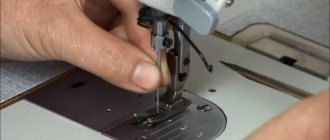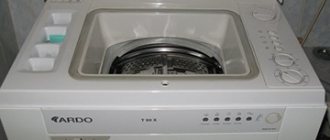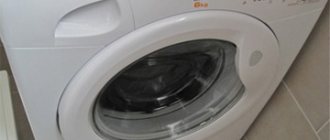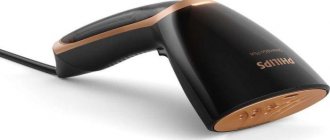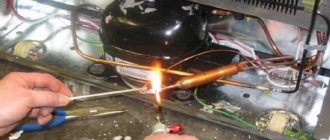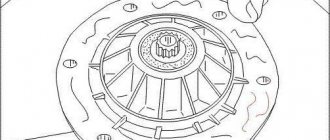Dishwasher structure and operating principle
When planning to repair a dishwasher with your own hands, you must accurately understand its design, the purpose of all components and the general principle of operation. The optimal configuration and configuration of this type of equipment has been around for quite some time. Almost all well-known manufacturers use them, adding only minor design changes and special modes for processing dishes.
The dishwasher is an indispensable assistant for the housewife in the kitchen.
In general, a dishwasher is a fairly spacious cabinet, inside of which there are special baskets for storing dirty dishes. Washing occurs due to jets of hot water hitting from all sides, to which surfactants can be added to increase efficiency.
For information! Modern technology uses a minimal amount of water due to its repeated circulation and filtration.
The water circuit includes:
- a volumetric tank, usually located under the washing chamber;
- receiving pipeline connected to the cold water supply system;
- shut-off valve with a water level sensor in the tank, responsible for the presence of the required amount of liquid during operation;
- circulation pump;
- a small container for powder or cleaning solutions;
- filters for coarse and fine water purification;
- nozzles and rotating sprinklers of various designs;
- pump for pumping out dirty wastewater, connected by a hose to the sewerage system.
In the dishwasher, appliances are treated with jets of hot water
Powerful heating elements are responsible for heating the water. The entire process is controlled by a control unit with pre-selected standard dish processing programs. Main modes:
- pre-wash;
- main wash;
- rinsing with clean water;
- drying.
The drying process can occur in two ways:
- Natural evaporation of liquid. To speed it up, the final rinse is done with hot water.
- Turbo drying using a fan that blows water vapor out of the chamber.
The principle of condensation drying in a dishwasher
Basic malfunctions and their elimination
Next, we list the most common defects and tell you how you can eliminate them by doing the repairs yourself. Many of them are associated with external factors, for example, low water pressure in pipes or insufficient voltage in the electrical network. Many malfunctions are associated with blockages in the drainage or drainage system of the PMM. This kind of problem is quite easy to fix on your own.
Dishwasher won't turn on
If such an event occurs, the first thing that comes to mind is that there is no supply voltage . This can happen for various reasons:
- the power cord is not plugged into the outlet or is damaged;
- no contact in the 220 V socket;
- the PMM input network filter has failed;
- The electronic control unit (hereinafter also referred to as ECU) is damaged.
A multimeter is a device that helps check the presence of supply voltage
In order to perform diagnostics and check the presence of supply voltage, the user will need a multimeter (hereinafter also referred to as a tester). This device is universal and can be used in the household for various equipment problems.
Damage to the power cord can lead not only to the shutdown of the PMM, but also to a fire.
The tester will allow you to determine whether there is voltage in the socket, and also check the wiring inside the PMM housing for a break. The surge protector may burn out due to excess voltage in the electrical network. A sign of damage is the presence of burnt elements.
In addition to the filter, a starting capacitor installed on the drain pump can prevent the dishwasher from turning on. The serviceability of the capacitor can also be checked with a multimeter by measuring its resistance. Damaged parts must be replaced with strictly similar ones: you should not experiment with the capacitance and permissible voltage of capacitors.
Damage to the ECU is less likely; such a breakdown is complex and requires qualified intervention. In addition to the above reasons, the source of the problem may be the lack of water in the water supply and the door not being closed until it clicks - in these cases, the operating program does not start.
The dishwasher is leaking
Water leakage in the bottom of the PMM is a fairly common malfunction that can lead to flooding of the room. Therefore, recently, almost all manufacturers have equipped their dishwashers with Aquastop protective systems (hereinafter also referred to as “Aquastop”).
Float and sensor of the Aquastop system located in the bottom of the dishwasher
We recommend: Types of malfunctions of clothing steamers and details of repairs
When water penetrates the bottom of the PMM, it lifts the polystyrene float. He begins to put pressure on the sensor, which triggers and sends a signal to shut off the water. The machine stops working, the liquid at the inlet is blocked by a solenoid valve built into the inlet hose. At the same time, the drain pump starts, which pumps water out of the dishwasher. The display shows an error code, which makes it easy to identify the malfunction.
Aquastop solenoid valve at the inlet hose
There can be several reasons for a leak:
- During installation, the dishwasher was not leveled, so the water overflows over the edge of the tank;
- due to poor-quality detergent or its overdose, excessive foaming is observed;
- the water level sensor (hereinafter also referred to as the pressure switch) is faulty, causing the machine to draw too much liquid;
- the seal of the door is broken due to loss of elasticity of the seal or its loose fit to the body;
- The Aquastop system sensor is faulty or the float is stuck.
Eliminating the above problems, with the exception of replacing the pressure switch and the sensor with a float, is quite simple. The condition of the door and excessive foaming are visible to the naked eye; setting the PMM level is also not difficult. In these cases, it is enough to eliminate the cause, remove the water from the pan, dry the machine, and it will be ready for use again.
In addition to the reasons listed, there is a possibility of a leak in the connection of one of the pipes located in the machine body. Read more about leaks and their elimination here.
From this video, readers can learn what to do if your dishwasher is leaking:
Water does not drain
In this case, you can also fix the dishwasher yourself. Problems with the drainage system can occur for several reasons:
- there is a blockage in the drain hose or it is simply pinched;
- sewer clogged;
- the filter element is clogged because it has not been cleaned for a long time;
- The drain pump does not work.
Owners can solve problems with sewerage themselves or call plumbers for this. The filter must be removed and washed thoroughly in warm water and dishwashing detergent to remove grease from the fine mesh.
Removing the filter from its slot for cleaning
You can check the drain pump impeller for free rotation without disassembling the machine body. Access to it will open if you unscrew the hexagon socket screw (TORX) in the glass under the filter and remove the protective cap. You can then check the rotation with your fingers and remove the foreign object with tweezers if it is interfering with the pump.
Disconnecting the drain hose from the diagnostic pump
To diagnose the drain hose for blockages, you will have to disassemble the dishwasher body to get to its bottom. Otherwise, it cannot be separated from the drain pump. Read more about problems with drainage in PMM here. In addition, readers can watch a video that answers the question of how to unblock the drain pump of a Bosch dishwasher:
Water flows poorly or does not flow at all
This kind of defect is associated with insufficient water pressure or clogging in the PMM inlet filters. The malfunction may be accompanied by poor rinsing. To troubleshoot malfunctions, remove and clean the strainers at the inlet hose inlet and at its connection to the dishwasher body.
Coarse filter in the inlet fitting of the dishwasher housing
The Aquastop solenoid valve at the inlet hose may be faulty. To determine serviceability, it is enough to check the resistance of its winding with a multimeter. If the device shows an open circuit, the valve must be replaced. A working valve should have a resistance of 1.5 to 5 kOhm.
In addition, the intake valve in the PMM itself, which is controlled by the ECU, may fail. Also, the cause of poor fluid collection may be improper operation of the pressure switch, giving incorrect readings about its level.
Filter at the inlet of the Aquastop solenoid valve
From this video, readers will learn how to find out the reason for the lack of water supply:
Poor dishwashing quality
In this case, you need to pay attention to whether you are operating the dishwasher correctly. Most often, it is this factor that affects the quality of washing kitchen utensils. For example, not enough washing gel or powder is loaded, dishes are not placed in baskets correctly.
Incorrect placement of dishes is one of the main reasons for poor washing quality
Another probable reason is the formation of scale on the electric water heater. As a result, the liquid does not heat up to the required temperature, which prevents the proper cleaning of kitchen equipment from dirt and food debris. How to clean PMM and its parts from scale, read here.
The nozzles in the sprinkler rocker arms must be cleaned regularly
Another probable reason for poor washing is contamination of the holes in the rocker arms of the sprayers (nozzles). To clean them, you need to remove the lower and upper sprinklers from the chamber and clean their holes with a toothpick, picking out the dirt out.
In many cases, you can diagnose and repair a dishwasher yourself. It is worth calling a specialist in difficult situations when your own strength has been exhausted. Readers can find more detailed information about all common PMM malfunctions on our website.
Causes of malfunctions
There are many factors that can cause any dishwasher to malfunction. The main ones:
- Natural wear and tear of parts that have exhausted their service life.
- Poor quality assembly or the use of defective materials, which is typical for cheap models from dubious manufacturers.
- Careless handling.
- Malfunction of the plug, socket or other elements of the external electrical network.
- Incorrect hose connections causing excessive tension or vibration.
- Regular entry of large pieces of food into the washing chamber with dirty dishes.
- Using detergents not recommended by the machine manufacturer.
- Incorrect loading of dishes.
- The spring is loose or the door latch mechanism is dirty.
Be careful! Sometimes simply sloppy closing of the loading hatch prevents the machine from starting.
Reasons for dishwasher failure
This section discusses situations when a machine that has been in service for less than 5 years or its warranty period stops working, because in this case the cause of the malfunction is most likely normal wear and tear of one of the modules.
If the dishwasher was purchased relatively recently and does not have, so to speak, a high mileage, the reasons may lie in the following:
- Low quality parts or assembly. This is a common diagnosis of devices purchased from Chinese or little-known manufacturers in order to save money.
- The user loads dishes with large food debris that clogs the filter. It also happens that the machine does not wash heavily soiled dishes well and the plates have to be washed and rinsed manually.
- Poor condition of the electrical network or outlet. It has nothing to do with the machine itself, but often occurs due to ignoring the special requirements for organizing the power supply of the equipment.
- Incorrect installation of the device. For example, the water supply hose is poorly secured or the drain hose is longer than necessary.
- Inappropriate or poor dishwashing detergent.
- The reason that the dishwasher does not fill with water may be that the door is not closed tightly. Because of this, the contacts that start the washing cycle do not close.
- The machine may not wash dishes well due to improper loading. To avoid situations where the device cleans only part of the items, you need to study the loading rules in the user manual.
With the exception of the first point, the problems described here can only be considered relative malfunctions that are not related to breakdowns. Any housewife can fix most of them with her own hands. In the future, we will mainly talk about breakdowns of internal modules and situations where it is impossible to restore functions without penetrating inside the device.
If the washer does not start
This happens approximately as follows: after setting up the cleaning program and loading dishes, you closed the chamber, the machine filled and heated water, but the washing process itself does not start. The reasons for this may be the following malfunctions:
- This often occurs due to a clogged drain filter under the chamber. The problem can easily be solved with your own hands - you need to turn off the machine, remove the filter and rinse thoroughly.
- Water sprays poorly or does not spray at all due to clogged spray nozzles. Due to clogging of these holes, water pressure may drop noticeably, which causes poor washing of pots. The injectors can be easily cleaned with a toothpick, but if the rocker arm itself does not rotate, then the reason should be sought in the circular pump, the breakdown of which is often encountered in this situation.
- If the circular pump breaks down, drawing water becomes technically impossible. This malfunction is considered one of the most difficult, but can be solved by simply replacing the part. Those who plan to do this with their own hands should know that to gain access to this unit you need to unscrew all the fasteners to the body and tubes. The pump itself is located at the bottom of the machine.
Problems with water supply, drainage and heating
The reason that the machine takes too much water into the washing chamber is a malfunction of the corresponding sensor. In this case, you can also carry out repairs yourself. You just need to buy a replacement similar device and install it in place of the broken one. The water level sensor is located at the very bottom of the device.
If water flows inside the dishwasher when it is turned off, the solenoid valve is faulty, interrupting the flow of liquid inside. Replacing it is also not particularly difficult, provided you purchase a suitable model.
The machine does not completely drain waste water into the sewer system if the corresponding pump is faulty or the drain system is clogged. In such a situation, you need to get to the drain pump, clean it of debris and check the resistance on the windings. If this does not help, you should check all the hoses of the drain system, the siphon and the filter located at the bottom of the chamber.
Often the cause of malfunctions of the drain system is its incorrect installation. This often occurs when installing washing machines - the drain hose rises too high and some of the water returns to the chamber after the pump is turned off.
Why does the machine turn on and start the cycle, but produces a lot of steam and heats the water too much. In this case, the cause of the problem is a breakdown of the temperature sensor, which should stop the operation of the heating system. Some models will automatically stop working. Replacing the sensor also does not seem to be a very difficult task.
The opposite situation - when the water does not heat up well - can be caused by the following violations:
- disabling the temperature sensor (heating does not turn on if the control system does not receive a signal from it);
- with low water pressure on the nozzles or pump (reasons described above);
- The heating element has failed - its functionality is checked using a multimeter.
If the car gives you an electric shock
The reason for the flow of electric current to the human body in contact with the body of the dishwasher is the breakdown of the heating element. Voltage is transmitted through water when the integrity of the tubes of this element is damaged. This happens when the device is used with too hard water, or when the internal switch fails. If the machine is electrocuted, you need to open it and examine the heating element for damage. If there are any, they should be replaced.
Detergent set
If the dishwasher does not pick up the cleaning powder or tablet well during the washing process, it means that water is not getting into the dispenser. As a rule, this occurs due to weak pressure. Another reason is the failure of the intake valve. The valve may not close well or may not open at all, causing the tablet or powder to only partially dissolve.
Noise
The most common cause of extraneous noise during operation of the dishwasher is wear or damage to the bearings of the electric motor or pump. Failure occurs due to water entering the bearings and seeping through the seal. The car starts to hum. In this case, the bearings and oil seal should be replaced.
Noisy operation of the dishwasher may be caused by debris getting into the spray arm or impeller. You need to get to them, remove debris and check the integrity of the impeller.
Possible causes of water leaking onto the floor
- The car door does not close well due to poor condition of the seals. They need to either be cleaned of plaque or replaced.
- The pump pumping water has a broken seal and is leaking water out. You can try replacing the seal, but replacing the entire device is safer.
- The clamps on the supply or drain hose are poorly tightened or there are no seals at the junction of the pipes.
- Damage to the water tank. It is not possible to repair the tank, so it is simply replaced.
Experienced craftsmen advise placing a newspaper on the floor to detect the exact location of the leak, after first removing the casing from the unit. If the paper gets wet, the source of the problem will be immediately visible.
Dishwasher breakdowns and how to fix them
Since the reasons for the breakdown of your dishwasher can be different, the methods for eliminating them must be applied in accordance with the specific situation.
You can fix many dishwasher problems yourself.
The washing process does not start
You have loaded the dishes and turned on the wash cycle. All indications are displayed in the usual way, the characteristic sound of filling the tank with water is heard, but its circulation does not begin. There are several options to check:
- The filter installed at the outlet of the pan at the bottom of the chamber is clogged. It must be removed, washed with a stream of water and replaced.
- Injector nozzles are dirty. You can often fix this problem by cleaning the holes with a regular toothpick.
- Failure of the circulation pump. The repair will consist of replacing it with a similar unit. If you are not confident in your ability to correctly install the pump and connect the motor to the electrical circuit, contact a specialist. Sometimes the cause of failure is a broken electrical circuit. In this case, the technician needs to ring the circuit and check the motor winding for an interturn short circuit.
Clue! A malfunction of the circulation pump may be indicated by the absence of a characteristic sound that always occurs during normal operation.
The water is overflowing
The reasons for the continuous flow of fresh water into the tank may be:
- breakdown of the level sensor located in the tank;
- Faulty solenoid valve on the filling line.
In both cases, you will need to open the dishwasher body and replace the defective device with a new one.
Overheating or underheating of water
The cause of excessive heating of water, accompanied by the formation of a large amount of steam, can only be incorrect operation of the temperature sensor. It will have to be replaced.
In case of low heating, the following options are possible:
- sensor failure;
- heating element failure.
The heating element is checked with a multimeter and replaced if a malfunction is confirmed.
Doesn't drain
The lack of pumping of dirty water into the sewer can be explained by a breakdown of the corresponding pump or a blockage. Contaminants are combated by disassembling the butt joints of the drain hose, siphon and sewer pipe, followed by mechanical cleaning and rinsing with plenty of water. If the pump fails, it will have to be replaced.
On a note! Sometimes incomplete pumping of waste water may be due to an unreasonably high location of the drain hose. By securing it lower, you can easily get rid of such a nuisance.
The body is electrocuted
Electric shocks indicate a short circuit of live parts to the device body. This means that the electrical circuit of the dishwasher has broken down. The most likely reason for this is a breakdown of the heating element shell. To verify this, it is enough to remove it from the socket and carry out an external inspection.
If your dishwasher is electrocuted, the heating element is broken.
If cracks or other defects are detected, immediately change the heating element.
Doesn't pick up detergent
If you find that the powder or tablet with detergent after washing the dishes is not completely dissolved, then this is due to three reasons:
- insufficient pressure of incoming water;
- clogged receiving filter (for models equipped with it);
- solenoid valve malfunction.
Make sure the water supply system is working properly, wash the filter to remove rust and other mechanical deposits, replace the valve if the first two steps do not lead to success.
Lack of power
The lack of power can be judged by the non-functioning indication on the control panel and the machine ignoring your pressing of the start button. In this case, you should check the possible problems one by one:
- there is no reliable contact inside the socket or the machine at the entrance to the apartment has tripped;
- The network filter has failed;
- breakdown of the start button mechanism;
- the loading door is not tightly closed;
- the lock burned out.
Problems with the cord - a possible dishwasher malfunction
The defective device is found using a multimeter and careful inspection. The nature of the repair is determined by the degree of damage to the parts.
Extraneous noise
Increased noise is always associated with improper operation of rotating parts. First of all, check to see if a foreign object has entered the sprayer's coverage area. If this is not the case, then there is a high probability of destruction of the pump or electric motor bearings. This happens when water leaks through a weakened seal. There are two repair options:
- Replace the oil seal and defective bearing.
- Purchase and install a new pump.
The first of them is labor-intensive, the second is more expensive.
Dishes won't dry
The problem with poor drying of dishes is always associated with a broken fan. This can be determined by ringing it with a tester. Usually it cannot be repaired, but simply replaced with a new one.
Water leaking on the floor
The appearance of water flowing from the bottom of a household appliance requires immediately unplugging it from the outlet and searching for the reason why your dishwasher is leaking.
If the dishwasher is not level, water overflows
Most likely, the culprits of the flood will be:
- Elastic door seals. Dirt may stick to them. They often fray or tear. They can be easily cleaned or replaced.
- Pump seals or loose clamps at hose connections. They are replaced or tightened until the leak is eliminated.
- Defective water tank. It is usually not repaired, but replaced with a new one.
To begin repairing a current dishwasher with your own hands, you need to accurately determine the location of the leak. To do this, lay dry newspapers and follow the appearance of wet spots.
Attention! Sometimes leaks occur due to excessive foam formation. Check whether the detergent you are using is correct.
Unexpected machine shutdown
If the machine turns off during operation, the reason for this may be:
- external problems associated with voltage fluctuations in the network or the operation of a circuit breaker in the electrical panel;
- internal damage to the electrical circuit, which includes the activation of the lock and failure of the control unit. An experienced technician should be involved in their repair.
If your dishwasher is faulty, do not delay repairs.
Foam does not wash off after washing
The presence of foam in the chamber after washing is completed indicates a failure in the settings of the control unit or incorrect use of the detergent. Some models do not recognize 3-in-1 tablets, and they do not have time to completely dissolve before the end of the full processing cycle. Re-read the operating instructions and act in accordance with their recommendations.
Advice! Often, a clogged filter prevents proper circulation and replacement of solutions. It should be repaired and cleaned regularly.
Typical breakdowns and repair recommendations
With machines whose warranty period has expired, everything is simpler - you can disassemble them, try to replace small parts yourself, and if you have enough experience, then carry out complex repairs.
Let's look at the most common problems faced by dishwasher owners and find out how to get these irreplaceable assistants to work.
Problem #1 - poor cleaning quality
If your dishwasher does not wash dishes well and does not completely wash the dishes, we are looking for the reasons for the “wrong behavior”.
Whitish stains on plates, food residues smeared on the bottom of a pan, glasses that have lost their transparency - all these are signs of poor-quality washing.
They appear when the rules for operating the machine are violated or the wrong choice of detergents is used. We have provided recommendations for choosing the best detergents here.
Poor cleaning is also often caused by untimely cleaning of filters.
It’s easier to start checking by inspecting the internal surfaces and parts. It is necessary to unscrew the filters, remove the spray arms, thoroughly clean everything with brushes under running water and put it back in place.
How does this happen:
To clean small holes, use improvised tools - brushes with long bristles, toothpicks, thin plastic ties.
The most convenient way is to use a microfiber cloth with a little detergent applied to it. Then rinse everything off and wipe dry
Joint areas often suffer from accumulated dirt and rubber parts wear out quickly - regular cleaning is recommended
We recommend: What to do if the dishwasher does not drain water and stops: deciphering error codes
The filters are located at the bottom, under the lower basket. They must be carefully unscrewed, washed, cleared of sediment and replaced.
The nozzles (holes) in the rocker arms need to be washed
Cleaning walls and baskets from plaque
Removing dirt from door joints and seals
Cleaning the drain filters
The filter mesh on the water supply hose also needs to be washed regularly. If it becomes clogged with dirt particles, the water pressure weakens, and the dishes are poorly rinsed.
Incorrectly selected detergents or improper dosage also affect the quality of washing.
The lack of rinse aid results in powder stains remaining on glass and ceramic dishes. The same result is achieved by using products not intended for use in PMM.
Carefully read the instructions for the machine, especially the section on detergents, and also read the recommendations for powders and rinses.
Dirt on the dishes can also remain due to poor preparation of heavily soiled pans and pots. If large, hard, dried-on pieces of food are not removed, some of them will remain or end up in adjacent trays
Be sure to follow the stacking order recommended by the manufacturer - place cups in the top tray, plates in the middle, and large utensils in the bottom. If you violate the scheme, then heavily soiled dishes will not receive sufficient care.
Problem #2 - water remains inside the case
A small puddle at the bottom of the washing chamber is a sign of normal functioning of the machine.
A certain amount of liquid is necessary to maintain a certain level of humidity - with it, rubber seals do not dry out and remain elastic longer. But excess water is a signal of a malfunction of the PMM.
If the water level in the pan is above 1 cm, and food remains are floating in the cloudy liquid, then you need to look for the cause of the breakdown in the drain pumping system
There are several main reasons for water stagnation in the pan:
- the outlet hose is connected too high, which is why the water is in no hurry to leave the washing chamber; it is necessary to lower the outlet to a height of 35-45 cm;
- blockage caused by improper care - filters should be cleaned approximately once every 1-2 weeks;
- pump - malfunction of the pumping device;
- sensor – failure of the water level sensor.
If the first two reasons can be eliminated on your own, then difficulties may arise with the second. Broken sensors or pump require replacement.
The best way out is to invite a specialist from the service center for detailed diagnostics and selection of suitable spare parts.
Both types of parts (pump and sensor) can be original or alternative. The original ones usually cost more, while the Chinese counterparts are cheaper.
However, when trying to save money, do not go wrong with the quality of spare parts - it is better to read reviews in advance and consult with a service employee.
Problem #3 - unexpected machine shutdown
A dishwasher that stops working before the end of the cycle is an alarming signal. An isolated case can be explained by an electronic system failure or a power surge, but regular shutdowns most likely indicate problems with the power supply.
To begin with, you can apply a restart - press the “on” button. after 20-30 seconds. If the washing process has started, the current in the network has stabilized.
If the network is weak and overloads occur from time to time, it is better to invest in a stabilizer - this way you will prevent possible failures and thereby save machine parts.
The cause of a temporary lack of voltage in the network can be electrical installations - sockets, tees or filters.
“Middlemen” between the outlet and the power cord should be avoided; it is better to use a direct connection. But if you still use a surge protector, then choose a device with a fuse.
Often a shutdown occurs due to a breakdown of the heating element (the arrow points to it in the figure). A thick layer of limescale or a hole leads to overload and the machine automatically switches off
If you have previously replaced the heating element in a boiler or washing machine, you can also repair the dishwasher. It is important to correctly select a part similar to the broken one and carefully install it.
Do you have a Bosch dishwasher and is it having problems with the heating element? We recommend that you read the instructions for replacing the heating element yourself.
The most difficult thing is when the dishwasher is constantly stopped by the control module with malfunctions in the program. It is almost impossible to repair it on your own, so it is better to invite a specialist to diagnose and repair it.
Problem #4 - unregulated water drainage
Such a malfunction may not be noticed immediately. The motor and pump of the machine are constantly in operation, water enters and immediately leaves the washing chamber, while the dishes still remain dirty.
If you look at the cold water meter, the problem can be identified faster - it collects liters that are wasted down the drain.
If the sensors are working properly, an error code appears on the display. It differs for different brands. For example, Bosch dishwashers issue code E15 - activation of the Aquastop system, which protects against leaks
However, sometimes the electronic control system does not work, and you have to guess based on indirect signs - water drainage, pump operation.
If the water inlet valve is faulty, the process of filling and draining becomes endless. Water flows in, but there is no signal to stop. An overflow is created, which is eliminated by automatically turning on the pump.
In such cases, you can do one of the following:
- Turn off the water.
- Turn off the power supply.
- Reach the connection point for the inlet hose.
- Disconnect the hose and remove the filter.
- Locate the valve and check its functionality.
Use a multimeter to check. The probes are attached to the intake valve contacts and determine the resistance. The norm is 500-1500 Ohms, other values indicate a malfunction. The broken part must be replaced.
Another reason is electronic failure. The repair can be done by anyone who can resolder the pump triac or perform similar actions. Otherwise, it is better to contact the service center.
Problem #5 - dishes are not drying
Remaining drops of water on dishes can turn into unsightly spots and stains, so the dishes must be dried thoroughly. If the dishwasher regularly does not dry the dishes, we determine the reasons on our own.
We recommend: How to remove water-based paint from a ceiling
The most common type of drying in budget and mid-range dishwashers is condensation.
That is, the dishes dry naturally, and only the body heated after washing helps them do this. Once the metal cools, the drying process will slow down. To extend it, the car door is opened slightly.
You can use a towel and dry all the plates by hand, but it is better to find out what is causing the drying problem and fix the problem if possible.
The first reason is a breakdown of the heating element or temperature sensor . Repairs will not bring much success, so it is better to replace these parts immediately. When replaced at a service center, they sometimes provide a 6-month warranty on the newly installed part.
The second reason is the fan . It applies to machines equipped with turbo drying. If the fan fails, the forced supply of hot air stops and the dishes remain damp.
The solution is to replace the fan. It can be located both in the upper and lower parts of the washing chamber, and on some models - on the side.
When choosing a new one, you should consider the make and model of the car. A “non-original” part will not fully cope with its task, so try to choose an analogue of the broken device that is suitable in terms of technical characteristics.
Problem #6 - The car makes a loud noise
This is one of the most common complaints received from consumers when a dishwasher is sent in for repair. A loud noise, not typical for a working machine, indicates the failure of one of the parts.
There are two main reasons: the the pump has failed .
To replace the bearing, you must remove the pump by following these steps:
- turn off the power supply;
- dismantle the pallet;
- unscrew the pump, loosening the clamps;
- Carefully disconnect the wires and pipes.
Having removed the pump, we disassemble it to get to the bearing. First, remove the heating element, then remove the impeller and armature.
Unfortunately, the parts of modern inexpensive machines are not reliable and can last on average 3-4 years. Then the worn out parts are replaced again.
In the depths, under the other parts, there is a bearing. Under it there is a gasket, which is also a consumable. If it is worn out, it is better to replace it immediately, otherwise you will have to disassemble the pump again later.
We take out the “knocking” bearing and insert a new one in its place. We perform assembly in reverse order.
Installing a new pump follows the same procedure: we dismantle the old device, find the breakdown and, if it is serious and cannot be repaired, replace it. For ease of work, the machine can be placed on its side if conditions permit.
Problem #7 - foam does not wash off after washing
The dish cleaning process is designed in such a way that first the detergent enters the chamber, then the rinse aid, and at the end all remaining substances are washed off with water.
If at the end of the cycle there are foam residues left on the bottom of the chamber, on the walls or baskets, this indicates either improper use of detergents or a failure in the settings.
Some users do not spare the powder, do not follow its dosage, and, on the contrary, do not use the rinse aid. As a result, the foam is poorly washed off and remains on the dishes and elements of the lower section.
To avoid violent foaming, you need to study the instructions, remember the dosage and follow the manufacturer's recommendations.
A number of models are not designed for the use of 3-in-1 tablets . As a result, the machine does not correctly recognize the product, and by the end of the cycle it does not have time to completely dissolve.
If the function of using universal tablets is present, but separate products were previously installed, you need to change the dishwasher settings. How this happens is described in detail in the instructions.
A clogged filter can also be the cause of excessive foam at the bottom of the box. Residues of food serve as an obstacle to the drainage of water, especially foamy water, as a result of which some of it remains at the bottom by the end of the cycle. The situation will be improved by simply cleaning the filter.
Electronic prompts about the type of failure
Modern models are equipped with an internal self-diagnosis system. It controls the operation of most critical units, constantly comparing it with the nominal parameters. If a fault is detected, the machine stops and an error code appears on the display. All of them are present in the product instruction manual.
Find a table with recommendations for troubleshooting common problems. They are the ones who will show you the right path to how to repair a stopped dishwasher yourself.
Watch a video about the main causes of dishwasher failure
Dishwasher does not wash dishes well
There is a possibility that the following problem will occur: the machine is set to the desired operating mode, each indicator works properly, the sound of water movement can be heard, the heating process does not work, but the dishes are not washed. There are several reasons why a dishwasher does not wash dishes well.
Firstly, the filter located at the very bottom of the washing compartment often becomes clogged. In such a situation, repairing dishwashers yourself will simply involve removing the filter and cleaning it.
Secondly, the nozzle gets clogged just as often. The consequence of this will be a weak splashing of hot water or no hot water at all. Such breakdowns negatively affect the water supply pressure inside the chamber. Consequently, the dishes will not be washed well. In such situations, a regular toothpick can help to clean the nozzle holes. Also, the nozzle “arm” itself may not rotate. In this case, you should pay attention to the circulation pump. Its breakdown is also a common occurrence.
Thirdly, as already mentioned, the circulation pump breaks down. Through it, water flows to the nozzles. In this case, repairing dishwashers on your own becomes somewhat more difficult due to the severity of the breakdown. To set up the equipment, you will need to completely replace the faulty part. To repair a dishwasher with your own hands, you need to open access to the pump located at the bottom of the chamber and disconnect all existing communications and fasteners from it. Then install the correct part.
How to understand that the reason for equipment failure is in the pump? When the water fills and the machine goes quiet, the pump is most likely faulty.

